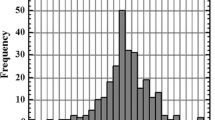Abstract.
A statistical model for the evaluation of the emission intensities of single spark discharge spectra on three different spark OES instruments (ARL 4460, OBLF-QSN 750, SpectroLab) was developed for the analysis of non-metallic inclusions in steel. In total, the raw measurement data consists of several thousand data points (intensities), about 2000 per element channel. A histogram (frequency distribution of pulse height intensities) of inclusion-forming elements like Al, Ti and Mn performed in intensity classes and the related frequencies contain the information of the measurement.
Measurement of a pure iron sample with slag powder rubbed into the surface by single spark emission spectrometry changes the originally (nearly) symmetrical histogram for inclusion related element signals to higher intensities. Thus, the known asymmetry of the histograms for steel samples is explained by the presence of inclusions.
A sum of Gaussian fits representing the histogram was expected to express the different elemental species and inclusion sizes by using the variables mean, standard deviation and area of the peak containing the information of the measurement. Even a less complex approximation using a sum of two Gaussian fits is not practicable for the Al, Ti and Mn channel and the three spectrometers due to too many variables in the fitting function resulting in a large scattering. Coincidences of high signals in different element channels could be seen only in terms of MnS.
A further attempt was to form the second differential of the logarithmic normal distribution and to compare the resulting partial areas below the functional graph to get information about the asymmetry of the fitting function of the original histogram. Two different procedures to evaluate the effect of the inclusion concentration on the size of the partial areas were applied to measurements on a set of synthetic samples with different concentrations of aluminium oxide in micro alloy steel. The results of both evaluation procedures correlate significantly with the inclusion concentrations. Electronic Supplementary Material is available if you access this article at http://dx.doi.org/10.1007/s00216-002-1595-1. On that page (frame on the left side), a link takes you directly to the supplementary material.
Similar content being viewed by others
Author information
Authors and Affiliations
Additional information
Electronic Publication
Rights and permissions
About this article
Cite this article
Kuss, HM., Lüngen, S., Müller, G. et al. Comparison of spark OES methods for analysis of inclusions in iron base matters. Anal Bioanal Chem 374, 1242–1249 (2002). https://doi.org/10.1007/s00216-002-1595-1
Received:
Revised:
Accepted:
Published:
Issue Date:
DOI: https://doi.org/10.1007/s00216-002-1595-1




